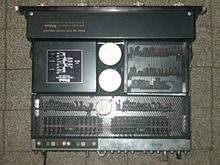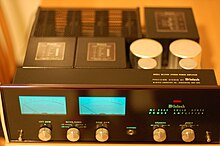McIntosh Laboratory
| McIntosh Laboratory, Inc.
|
|
|---|---|
| legal form | Corporation |
| founding | 1949 |
| Seat |
Binghamton , New York , United States |
| Branch | Consumer electronics |
| Website | www.mcintoshlabs.com |
McIntosh Laboratory is an American manufacturer of audio and home theater equipment. The company positions itself in the high-end and luxury segment of the audio industry. The range of devices includes amplifier components , tuners , CD players , record players, multi-channel components, equalizers , oscilloscopes , laser disc players and loudspeakers . Records were also produced for a short time . In Europe , the company is particularly known for amplifiers and tuners. Most of the speaker series were not offered here.
In contrast to companies such as Marantz , Fisher and Harman / Kardon , McIntosh was able to maintain its independence from Japanese manufacturers even after 1990. From 1990 to 2003 the company was owned by Clarion , which was sold in May 2003 to D&M Holdings Inc. , also a Japanese holding company. In 2008 D&M Holdings was taken over by Bain Capital , a US company.
In 2012 McIntosh Laboratory was taken over by the Fine Sounds Group from Italy.
Today it is still produced exclusively in America . The only concessions that had to be made to the Asian owners at the time were an inexpensive pre- and power amplifier combination and a car audio line.
history
The first years
In 1947, Frank McIntosh founded McIntosh Scientific Laboratory, based in Washington, DC. In 1949, the company moved to Silver Spring , Maryland , and developer Gordon Gow joined the young company. In 1950 McIntosh components could be ordered by mail order for the first time , and these were touted in large electronics mail order catalogs. In 1951 the next move came to Binghamton (New York) .
In 1954 McIntosh was also active in the field of recording technology and recorded various records, which they then brought onto the market. These are mostly classical and folk music , including a recording of Debussy's “Sonata”, which was interpreted by violinist Paul Olefsky . However, this venture appears to have been discontinued soon.
In 1957 the company moved to new premises on Chambers Street, where it is still based today. In contrast to a large part of the competition , which also sold their devices as a kit , McIntosh also only offered assembled components via mail order. Only the Mc30 mono power amplifier was also sold as a kit from 1960 to 1961.
The first stereo components
As was customary in those years, McIntosh first equipped their devices with additional stereo adapters. Thus a second unit called the C8S was launched on the market for the popular C8 preamplifier . This combination was sold from 1958 to 1960 until it was replaced by the C11 as the first “real” stereo preamplifier. The principle of the C8S is explained by the fact that it was a pure C8, which was simply provided with additional functions for balance and two-channel volume control.
The C8, which was sold from 1955, was - like most McIntosh devices at the time - not registered with the patent office . The circuit was copied by a competing company shortly after it appeared. In those years the combination C8 / C8S, with two Mc30 monoblocks, was McIntosh's best-selling audio system. The price of this combination was around US $ 500, which was a substantial investment . In 1960 the Mc240 was launched as the first stereo power amplifier, followed in 1961 with the C11, the first "real" stereo pre-amplifier. Nevertheless, depending on the model, the monoblocks continued to be produced until 1969. For cost reasons, many audio enthusiasts added a second monoblock to their existing combination instead of switching to a stereo power amplifier.
The transistor
In 1962 the first partially transistorized device appeared with the MX110- Preceiver , in 1964 with the C24 the first completely transistorized pre-stage. However, power amplifiers in transistor technology did not come onto the market until 1966. From this point onwards, McIntosh consistently built transistorized devices, and it was not until 1995 that tube components were produced again with the limited edition of the combination C22 / II and Mc275. For the 50th anniversary of the company, the Mc2000 appeared in 1999 in hybrid technology with 2 x 130 watts .
Power amplifier
Many power amplifiers were produced in different versions, which were specially designed for laboratory purposes, cinema sound reinforcement, transmission systems, etc. Various devices are provided with standard housings or designed as rack modules in small series.
Tuner (selection)
- 1957–1959: MR55 , tube unit, mono. The company's first tuner.
- 1962–1964: MR65B , tube unit, stereo. First “real” stereo tuner.
- 1963–1969: MR71 , tube unit, stereo. The last tube tuner.
- 1969–1971: MR73 , McIntosh's first transistor tuner .
- 1972-1979: MR78 , transistor device , stereo.
- 1980–1985: MR75 , transistor device , stereo.
- 1986–1990: MR510 , transistor device , stereo.
- 1990-1995: MR7083 , transistor device , stereo.
Others (selection)
- 1959–1963: C20 , preamplifier, tube unit, stereo.
- 1963–1966: MA230 , integrated amplifier, hybrid device , stereo.
- 1964–1967: MI3 , Maximum Performance Indicator (oscilloscope).
- 1960–1969: MC240 , power amplifier, tube unit, stereo.
- 1962–1969: MX110 , Preceiver, hybrid device, stereo.
- 1967–1973: MAC1700 , receiver, hybrid device , stereo.
- 1970–1978: MQ101 , equalizer, transistor device , stereo.
- 1995: MCD7009 , CD player.
particularities
The components from McIntosh are clearly recognizable as American devices, the design has followed a uniform line since around 1960, which was only slowly renewed. In contrast to the English high-end manufacturers, who were and are often designed for minimalist equipment, the devices from McIntosh have extensive equipment. This fact put a strain on the company's market position in the 1980s and 1990s, as the high-end sector was more geared towards simple devices.
However, McIntosh was able to secure its segment in terms of first-class manufacturing quality and its legendary reputation in the field of tube technology. In 1995 the C22 preamp and the Mc275 power amplifier were reissued in a limited series, but these are not identical replicas of the components from the 1960s. Since the company primarily supplies the American and Asian markets, the devices often have features that European customers tend to view with skepticism.
Wooden housings were optionally available for (almost) all devices, these are identified with the type designation "L". As a rule, this is walnut wood , but there are also few known cases made of other woods. The price of these accessories ranged from US $ 25 in 1958 to US $ 200 in 1995. The massive price - an MR71 tuner cost US $ 399 and the case an additional US $ 99 - held many customers in the 1960s and 1970s Years from purchasing this accessory.
literature
- David H. O'Brien: The McIntosh Amplifier Clinics. 1962-1991 . McIntosh Laboratory, Vestal, NY 1992.
- Ken Kessler: McIntosh “… for the love of music…” . McIntosh Laboratory, Vestal, NY 2006, ISBN 0-9787236-0-0 .
Individual evidence
- ^ Fine Sounds to Acquire McIntosh . In: Stereophile.com . October 8, 2012 ( stereophile.com [accessed October 4, 2018]).





